
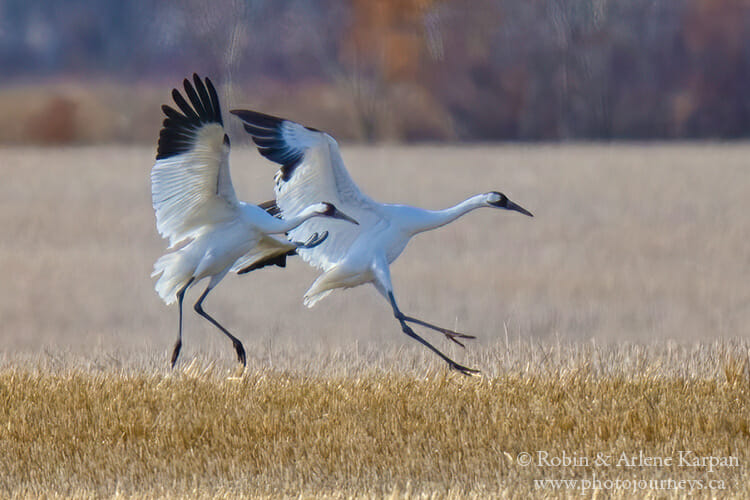
Saskatchewan is a hotspot for seeing and photographing whooping cranes, one of the rarest and most famous endangered birds in North America. Each fall these magnificent white birds migrate around 4,000 km from their nesting grounds in Wood Buffalo National Park, straddling the Alberta / Northwest Territories border, to their winter home in Aransas National Wildlife Refuge on the Texas Gulf Coast. They fly a direct and fairly narrow route, with their favourite stop along to rest and feed along the way being south-central Saskatchewan. Normally, they arrive around early to mid-October.
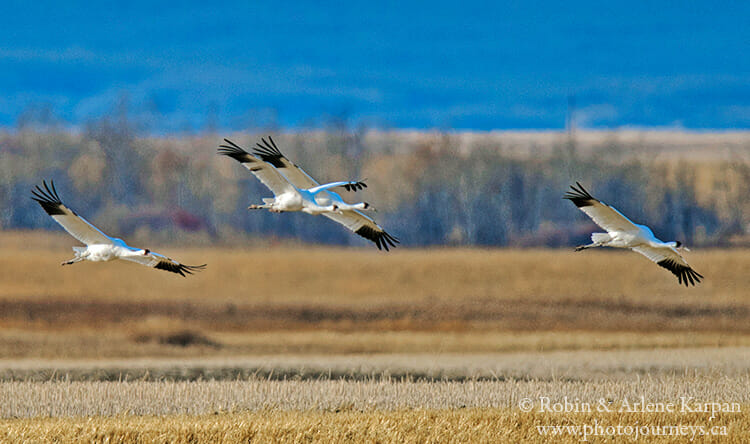
Exactly where they stop may vary from year to year, but it has usually been within an hour or so drive from our home in Saskatoon. Some places they tend to favour include Last Mountain Lake National Wildlife Area (North America’s oldest bird sanctuary), Muskiki Lake, Radisson Lake, and the pothole country southeast of Saskatoon.
In recent years the top hotspot has been the area around Blaine Lake and Marcelin, almost straight north of Saskatoon. They favour these places because of the combination of wetlands and nearby grain fields that make it handy for feeding. Typically they don’t all travel together, so it might be possible to find clusters of whoopers in different spots.
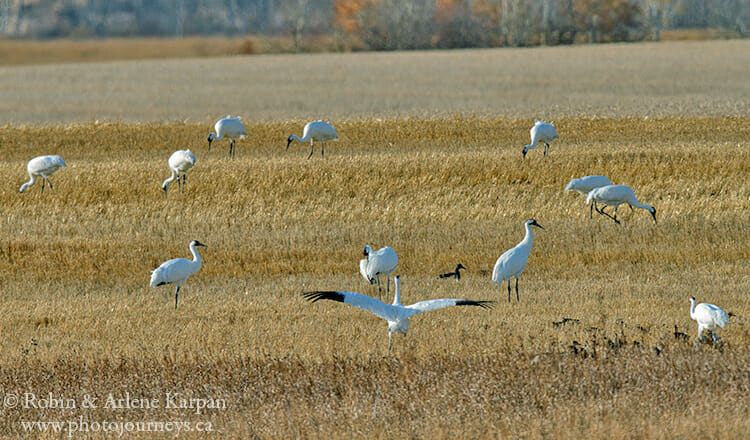
Back From the Brink, A Whooping Crane Success Story
Whooping cranes have come back from the brink of extinction. The population dropped to only 14 adult birds in the early 20th century. With conservation efforts in Canada and the United States, their numbers gradually recovered. Recent population estimates are over 500 birds.
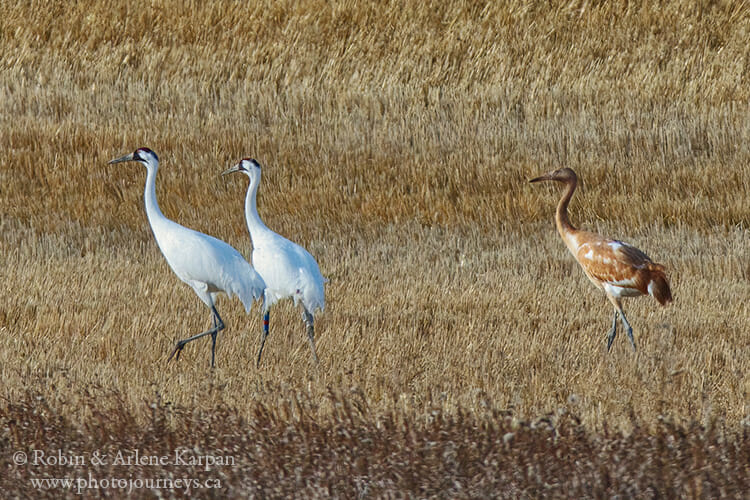
How to Recognize Whooping Cranes
Adults, with their pure white plumage and black wing tips visible in flight, can reach 1.5 metres in height — North America’s tallest bird. Their wing span can top an amazing two metres, yet this impressive bird weighs just over 7 kg. Immature youngsters are only slightly smaller and have reddish-cinnamon plumage. Their unmistakable call sounds like a bugle, with trumpet-like tones carrying far into the distance.
Whooping cranes can sometimes be mistaken for sandhill cranes. However, sandhills are smaller, and grey in colour. Whoopers have a bright red cap, and a red and black face mask. Also, sandhills travel in much larger groups.
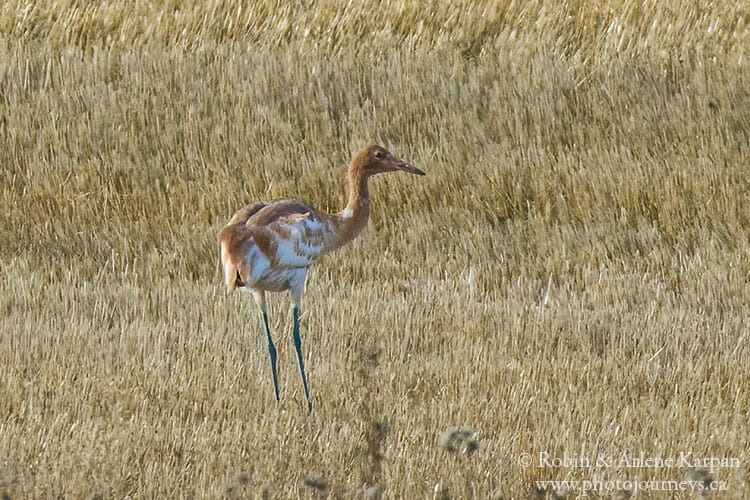
Whoopers Arriving in Larger Numbers
Only a few years ago, it was common to see small numbers of cranes at a time. But more recently we can usually find them in larger groups. On one photo trip this year, we could see 43 birds at once, plus there were certainly more in other parts of the field.
While seeing larger flocks is certainly more rewarding for birdwatchers and photographers, scientists have expressed concern that if a large flock were to suffer from a disease or an unexpected weather event, it could potentially wipe out a significant part of the total population.
One explanation for the larger flocks is not only that the total population has increased, but also because of disappearing wetlands, especially in the southern Great Plains of the United States. With fewer suitable wetlands, more birds are forced into fewer places.
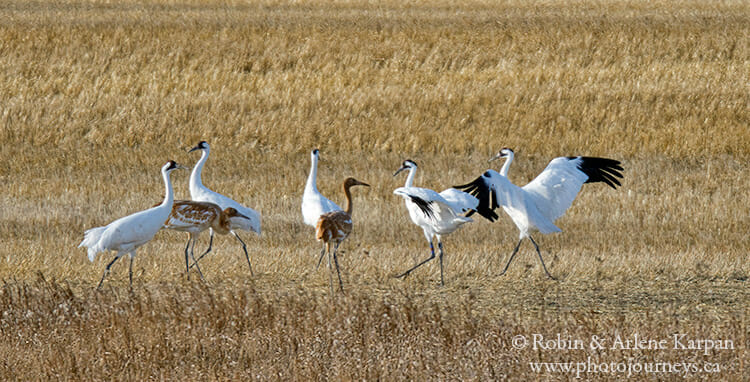
Whooping Cranes Are a Challenge to Photograph
Whoopers aren’t easy to photograph. They won’t tolerate people getting anywhere near. They like to feed in grain fields on their way south. The mostly open nature of this setting adds to the challenge, since there is often nowhere to hide to watch or photograph. The best strategy is to photograph from inside your vehicle on the side of the road, although this doesn’t always work. While they get used to traffic going by on the road, a car that stops might cause them to move away.
We had the most success during this year’s migration by finding a place to stop with bushes along the roadside. I could then walk into the bush and set up a tripod near the fence line of the field, while still being obscured by the trees. The cranes were still a long distance away and they never changed their behavior. I used a 600mm lens, but even with that I had to crop the images a fair amount when processing.

The whoopers tended to move around a lot. They would feed in one spot then slowly walk to another area. Every so often some made a fuss by flapping their wings at other birds. While most were in the same general area, they were fairly dispersed with small groups or a couple of birds, and even individuals off by themselves. Occasionally some would fly to another part of the field just a few hundred metres away.
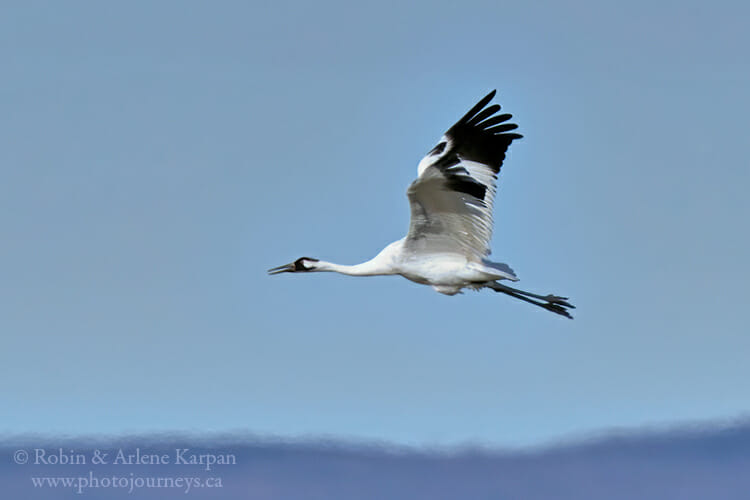
These short flights provided some of the best photo opportunities. They flew low and slow, gracefully gliding much of the way. As they came in for a landing, their feet came down and the wings tipped up as they almost did a running landing to slow down. Despite the challenges, watching and photographing these iconic birds ranks among Saskatchewan’s great outdoor adventures.
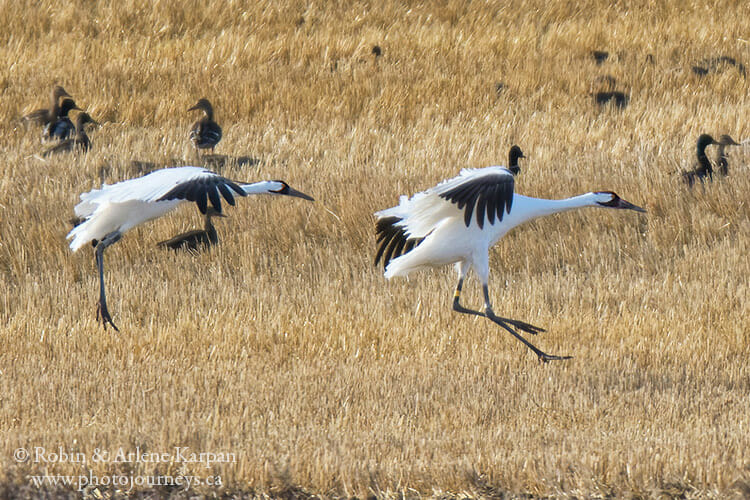
For more information on whooping crane identification, migration, protection, and conservation see Friends of the Wild Whoopers., a conservation group based in the United States.
SUBSCRIBE to Photojourneys below
Feel free to PIN this article on Whooping Crane Migration in Saskatchewan



An excellent article and we love our whooping cranes. The photos are fabulous! Thank you for posting.
Pam Bates
VP-FOTWW
Thank you for writing us Pam. We have included a link to your organization Friends of the Wild Whoopers in the article. Thanks for the good work you do.
Thanks for sharing your photos and wisdom on the Whoopers. Guy Wapple and Bob Holtsman are friends of mine
and they speak highly of you. I was lucky and blessed to go with Guy and a few friends a week ago and see the big white birds for the first time. Spectacular and your post on them further my learning a great deal.
Highest regards’
Todd
We appreciate your comments Todd, and we’re glad you enjoyed the article.